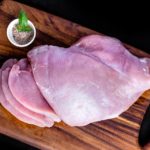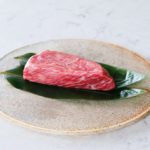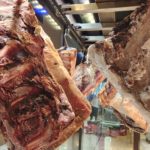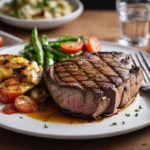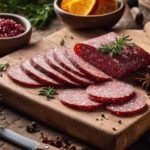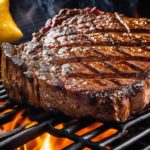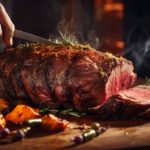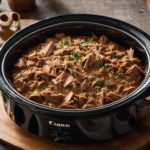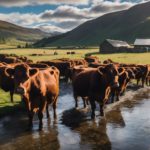Are you a meat lover intrigued by the world-class reputation of Japanese Wagyu beef? Known for its uniquely impressive quality, Wagyu is meticulously rated using an intricate grading system.
This blog provides an in-depth look at how this system works, breaking down everything from ‘Yield Grade’ to ‘Meat Quality Grade‘, and offering insights into what factors contribute to these ratings.
Get ready to become an expert on selecting top-tier Wagyu – your taste buds will thank you!
Key Takeaways
- Japanese Wagyu beef is rated using a two-part grading system: yield grade (A, B, or C) and meat quality grade (1 to 5).
- Yield grade assesses the amount of usable meat on the cow, while meat quality grade evaluates factors like marbling, color, firmness, and texture.
- A5 Japanese Wagyu Beef is the highest grade, known for its exceptional marbling and melt-in-your-mouth texture. It must meet qualifications such as high marbling levels and vibrant color.
- Marbling plays a crucial role in the taste and tenderness of Wagyu beef. It refers to the thin streaks of fat within the muscle fibers that add juiciness and flavor to each bite.
The Grading System of Japanese Wagyu Beef

The grading system of Japanese Wagyu beef consists of two main components: yield grade and meat quality grade.
Yield Grade (A, B, or C)
Yield grade ranks the amount of meat on a cow. It goes from A to C. Yield Grade A means there is lots of usable meat on the cow. Less meat gives a B or C grade. For example, if a big part of the weight is fat, not meat, it may get a lower yield grade.
This grading doesn’t tell how tasty or tender the beef is though!
Meat Quality Grade (1 to 5)
Meat quality grade matters a lot. It tells how good the beef is. The grades are 1 to 5 in the grading system used by Japan Meat Grading Association (JMGA). For wagyu beef, grade 5 is the best you can get.
The meat color and brightness come first. A rich and bright color means a top-quality score. Then comes fat standard, it should be white or slightly yellowish for high-grade Wagyu.
Firmness and texture also play their part in giving a high grade to Wagyu beef.
The next big thing is marbling, which gives this beef its amazing flavor and soft feel when you bite into it – that’s Grade 5! Beef Marble Score (BMS) shows how much fat spread through the lean part of meat there is.
For A5, Japanese Wagyu, this score goes from 8 to12.
Grades below show less of all these great things we love about Japanese Wagyu – lesser marbling , less desirable color , firmness or texture.
Factors Considered in Wagyu Beef Grading

The grading of Wagyu beef takes into account several factors, including the ratio of fat to lean meat, color, firmness, and marbling.
Ratio of Fat to Lean Meat
The ratio of fat to lean meat is vital in grading beef. More fat means a higher score. High-fat Wagyu beef often has rich taste and soft feel. This mix of fat and meat gives the beef its unique flavor.
If there’s too much lean meat, the taste may not be as good. So, a lot of fat gets you a high grade!
Color
The color of Wagyu beef plays an important role in the grading process. The Japanese Meat Grading Association considers the color of the meat to determine its quality. A bright red color is desired, indicating freshness and a high level of oxygen in the meat.
Darker colors may indicate less desirable factors such as older age or disease. Therefore, when seeking top-quality Wagyu beef, look for cuts that have a vibrant and appealing red color.
Remember, appearance matters when it comes to choosing the best Wagyu beef!
Firmness
The firmness of Japanese Wagyu beef is an important factor in its grading. When evaluating the firmness, experts look at how the meat feels when you touch it. They want the meat to be tender and have a nice texture.
Additionally, firmness can indicate the quality of the meat. The higher the grade, the better the firmness will be since higher-grade Wagyu beef tends to be more tender and melt-in-your-mouth delicious.
So when you’re enjoying a juicy steak, remember that firmness plays a role in making it taste so good!
Marbling
Marbling is an important factor in grading Japanese Wagyu beef. It refers to the white flecks of fat that are evenly distributed within the meat. The more marbling there is, the higher the grade of the beef.
And let me tell you, high-quality marbling is what makes Wagyu beef so special and delicious! This intramuscular fat gives the meat a buttery texture and incredible tenderness. When you cook a piece of Wagyu steak with lots of marbling, it melts into this amazing flavor explosion in your mouth.
So if you’re a fan of juicy, flavorful steaks, look for cuts with plenty of marbling!
Understanding A5 Japanese Wagyu Beef Grading
A5 Japanese Wagyu Beef is the highest grade of wagyu beef, known for its exceptional marbling and melt-in-your-mouth texture. Discover the qualifications for A5 grade and why it’s so highly prized.
Ready to drool? Keep reading!
Qualifications for A5 Grade
To achieve A5 grade, Japanese Wagyu beef must meet the following qualifications:
- The meat must have the highest level of marbling, indicating rich intramuscular fat.
- The color of the meat should be bright and appealing.
- The firmness and texture of the meat should be tender and succulent.
- The beef must have a high ratio of fat to lean meat, contributing to its melt-in-your-mouth quality.
- These factors combine to make A5 grade Wagyu beef the most sought – after and exquisite beef in the world.
Importance of Grade A Yield and Grade 5 Meat Quality
Grade A yield and Grade 5 meat quality are two important factors to consider when it comes to Japanese Wagyu beef. The yield grade tells us how much meat there is compared to the overall weight of the carcass.
Grade A means there is a higher amount of usable meat, which is great for getting more value out of your purchase.
On the other hand, Grade 5 meat quality refers to the highest level of marbling and overall quality. Marbling is those beautiful streaks of fat you see in the meat, and it gives Wagyu beef its amazing flavor and tenderness.
So, with Grade 5 meat quality, you can expect an exquisite eating experience that will satisfy even the most discerning steak lovers.
Comparison of A5 and A4 Japanese Wagyu Beef
A5 Japanese Wagyu beef is the highest grade, known for its exceptional marbling and tenderness, while A4 offers similar qualities but with slightly less fat content. Let’s delve into the differences to fully appreciate the flavor experience!
Differences in Grading Criteria
The grading criteria for Wagyu beef can vary depending on the country and organization. In Japan, the grading system focuses on two main factors: yield and grade. Yield refers to the ratio of meat compared to the carcass weight, while grade assesses qualities like marbling, color, firmness, and texture.
On the other hand, in countries like Australia and the United States, they use different systems based mainly on marbling scores. Japanese Wagyu beef is known for its high level of marbling, which gives it a rich flavor and tenderness that many meat lovers enjoy.
So if you’re looking for top-quality Wagyu steak with melt-in-your-mouth marbling, be sure to pay attention to these differences in grading criteria when making your selection!
Impact on Taste and Texture
The grading system for Japanese Wagyu beef has a significant impact on the taste and texture of the meat. Higher grades, like A5, have more marbling, which refers to the fine lines of fat that are dispersed throughout the muscle tissue.
This marbling gives Wagyu beef its melt-in-your-mouth tenderness and rich flavor. When cooked, the fat in A5 Wagyu melts and bastes the meat from within, resulting in a buttery texture and a juicy and flavorful bite.
The high marbling also contributes to a luxurious mouthfeel and makes each bite incredibly indulgent. So if you’re looking for an exceptional dining experience with extraordinary taste and texture, choosing higher grade Japanese Wagyu beef is definitely worth it!
Other Wagyu Beef Grades Explained
Grades B, C, and 1 to 4 offer a range of fat content and marbling levels that suit different preferences. Find out which grade is best for you by delving into the details!
Grades B, C, and 1 to 4
Grades B, C, and 1 to 4 are other grades used in the Wagyu beef grading system.
- Grade B indicates a lower level of marbling and overall quality compared to A5.
- Grade C is even lower in quality, with less marbling and tenderness.
- Grades 1 to 4 also have varying levels of marbling and overall quality, with grade 4 being closer to A5 in terms of quality.
Differences in Fat Content and Marbling
The fat content and marbling of Wagyu beef can vary depending on the grade. Higher grades, like A5, have more fat content and intense marbling compared to lower grades. Fat is important because it adds flavor and tenderness to the meat.
Marbling refers to the thin streaks of fat that run through the muscle fibers, giving Wagyu beef its distinctive melt-in-your-mouth texture. The higher the grade, the more marbling you can expect in your steak.
So if you’re looking for a rich and tender eating experience, choose a higher-grade Wagyu with plenty of marbling!
The Importance of Marbling in Wagyu Beef
Marbling is the intricate web of fat that runs through each slice of Wagyu beef, enhancing both its flavor and tenderness. Discover why marbling plays a crucial role in creating the ultimate Wagyu dining experience.
Read More to unravel the secrets behind this mouthwatering feature.
Definition of Marbling
Marbling is a term used to describe the small streaks or flecks of fat that are found within the muscle fibers of Wagyu beef. These thin lines of fat run through the meat, giving it a marbled appearance.
It’s like little pockets of flavor throughout the steak! The more marbling there is in the meat, the better. That’s because marbling adds juiciness and tenderness to each bite. When you cook Wagyu beef with lots of marbling, it melts into perfection, creating a rich and buttery taste that meat lovers go crazy for! So when you hear people talking about how amazing Wagyu beef tastes, a big part of that comes from its incredible marbling.
Influence on Flavor and Tenderness
The marbling of Wagyu beef has a big impact on its taste and tenderness. Marbling refers to the thin lines of fat that are distributed throughout the meat. It gives the beef a rich, buttery flavor and makes it incredibly tender.
The high level of marbling in A5 Japanese Wagyu beef means that it melts into the meat as it cooks, resulting in a luxurious texture and an intense flavor experience. So, if you’re a fan of juicy, melt-in-your-mouth steak with amazing flavor, then you’ll definitely appreciate the influence of marbling in wagyu beef.
How the Japanese Grading System Differs from Others Worldwide
The Japanese grading system for Wagyu beef differs significantly from other grading systems worldwide, such as the USDA grading system. The criteria and standards used to assess the quality of meat are unique to Japan, making it important for beef enthusiasts to understand these differences in order to fully appreciate the excellence of Japanese Wagyu beef.
Read on to learn more about how this system sets Japanese Wagyu apart from the rest.
Comparison to USDA Beef Grading
Understanding how the Japanese Wagyu grading system compares with the United States Department of Agriculture (USDA) beef grading system can provide a broader perspective on beef quality. The USDA grading system designates beef as Prime, Choice, or Select, largely based on the marbling and age of the beef. Below is a comparison of the two systems:
| Japanese Wagyu Grading | USDA Beef Grading | |
|---|---|---|
| Grading Factors | Emphasizes on yield grade, meat quality grade which includes marbling, color, firmness, and texture. | Focuses mainly on marbling and age of the animal. |
| Highest Grade | A5 grade. This indicates the highest level of marbling and overall quality. The degree of marbling plays a significant role in this system. | Prime. This indicates a high level of marbling and is considered superior in quality. |
| Grading Scale | Uses a combination of letters (A, B, or C) and numbers (1 to 5) to rate the quality of beef. | Uses descriptive words such as Prime, Choice, and Select to denote beef quality. |
| Quality Indicators | A high-quality Wagyu steak comes with a high marbling score. The meat is considered more tender and flavorful. | The quality of beef is largely based on the marbling and age. Prime beef is typically from younger cattle with abundant marbling. |
In summary, both systems are designed to maintain quality standards but they have different grading criteria. Japanese Wagyu grading system is more precise and comprehensive, while the USDA system is simpler but effective in its classifications.
Variation in Grading Criteria
The grading criteria for Wagyu beef can vary depending on the region and organization. For example, the Japanese Meat Grading Association (JMGA) has its own specific standards for grading Wagyu beef.
They focus on factors such as marbling, color, firmness, and texture to determine the overall quality of the meat. On the other hand, other countries may have different criteria when it comes to grading Wagyu beef.
It’s important to understand these variations and consider them when choosing your Wagyu steak.
How to Choose Top-Quality Japanese Wagyu Steak
To choose top-quality Japanese Wagyu steak, you need to understand the grading system, select the desired fat content and marbling level, and consult with experts or trusted retailers.
Read on to discover the secrets of finding the perfect cut for an unforgettable dining experience.
Understanding the Grading System
The grading system for Japanese Wagyu beef can be a bit confusing, but it’s important to understand if you’re a meat lover. The system ranges from 1 to 5, with 5 being the highest grade.
It also takes into account factors like marbling, color, firmness, and texture. One key thing to note is that the higher the marbling score, the more tender and flavorful the beef will be.
So if you want top-quality Wagyu steak, look for A5 grade which has the highest level of marbling and overall quality. Always keep in mind that the Japanese grading system is precise and comprehensive – they really know how to rate their beef!
Selecting the Desired Fat Content and Marbling Level
When choosing Japanese Wagyu steak, meat lovers have the opportunity to select their desired fat content and marbling level. Here are some tips to help you make the best choice:
- Look for a higher marbling score: The marbling of Wagyu beef is responsible for its rich flavor and tenderness. Opt for cuts with a higher marbling score, as this indicates more intramuscular fat and better flavor.
- Consider your personal preference: Different individuals have different preferences when it comes to the amount of fat in their steak. If you enjoy juicier, more flavorful meat, choose cuts with a higher fat content. If you prefer leaner cuts, go for ones with less visible fat.
- Experiment with different grades: Japanese Wagyu beef is available in various grades, ranging from 1 to 5. Each grade offers a unique combination of quality and marbling. Try different grades to find the one that suits your taste buds best.
- Consult experts or trusted retailers: If you’re unsure about which fat content and marbling level would be ideal for your palate, don’t hesitate to seek advice from experts or trusted retailers who specialize in Japanese Wagyu beef. They can provide valuable insights and recommendations based on your preferences.
Consulting with Experts or Trusted Retailers
To ensure you choose top-quality Japanese Wagyu steak, it’s always a good idea to consult with experts or trusted retailers. They have extensive knowledge and experience when it comes to different grades of Wagyu beef.
These experts can provide valuable insight on selecting the right fat content and marbling level based on your preferences. Trusted retailers often work directly with reputable producers, ensuring that you get authentic Japanese Wagyu beef of the highest quality.
So, don’t hesitate to seek their guidance and make an informed decision when purchasing this exquisite meat for a truly exceptional dining experience.
Conclusion
In conclusion, understanding the grading system of Japanese Wagyu beef is essential for meat lovers who want to savor the highest quality and most flavorful cuts. The combination of yield grade and meat quality grade determines the overall grade of the beef, with A5 being the top tier.
Marbling plays a crucial role in achieving this coveted grade, as it adds tenderness and flavor to the meat. So next time you’re looking for an exquisite steak experience, remember to consider the grading system and choose your Wagyu beef accordingly.
Enjoy!
FAQs
Q: What is the grading system for Japanese Wagyu beef?
A: The grading system for Japanese Wagyu beef is a method used to determine the quality of the meat based on a variety of factors including marbling, meat color, fat color, and overall quality score.
Q: How does the Wagyu grading system work?
A: The Wagyu grading system evaluates beef based on a numerical grading system, with the highest grade being A5, followed by A4, A3, A2, and A1. The letter represents the yield grade, which measures the ratio of usable meat to total weight, while the number represents the quality grade, which assesses marbling, meat color, and fat color.
Q: What does A5 Wagyu mean?
A: A5 Wagyu is the top grade of Japanese beef, indicating the highest level of marbling and the most desirable fat color and meat color. It is known for its rich flavor, tenderness, and melt-in-your-mouth texture.
Q: What is the difference between A4 and A5 Wagyu beef?
A: A4 Wagyu beef is slightly lower in marbling and quality compared to A5 Wagyu. It still offers an exceptional eating experience with tender meat and excellent flavor. A5 Wagyu, on the other hand, is the pinnacle of quality with abundant marbling and unmatched richness.
Q: Is the Wagyu grading system the same as the USDA grading system?
A: No, the Wagyu grading system is different from the USDA grading system used for beef in the United States. The Wagyu grading system focuses on marbling, fat color, meat color, and overall quality, while the USDA grading system assesses meat based on marbling, maturity, and yield.
Q: Can Australian Wagyu be as high quality as Japanese Wagyu?
A: Yes, Australian Wagyu can achieve high-quality grades similar to Japanese Wagyu. While Japanese Wagyu is considered the gold standard, Australian Wagyu also undergoes rigorous grading based on marbling, meat color, and fat color. It can provide a delicious and luxurious dining experience.
Q: Who oversees the grading of Wagyu beef in Japan?
A: The grading of Wagyu beef in Japan is overseen by the Japanese Meat Grading Association, a governmental organization responsible for ensuring the accuracy and fairness of the grading process.
Q: What is the best grade of Japanese Wagyu?
A: The best grade of Japanese Wagyu is A5, which represents the highest level of quality and marbling. A5 Wagyu offers a luxurious and indulgent eating experience that is highly sought after by beef enthusiasts.
Q: What is the difference between Wagyu and Kobe beef?
A: Wagyu refers to any beef from Japanese cattle breeds, while Kobe beef specifically comes from the Tajima breed of Wagyu cattle raised in the Kobe region of Japan. Kobe beef is known for its exceptional marbling and flavor, making it highly prized and often regarded as the epitome of Japanese beef.
Q: What cuts of steak are commonly associated with Wagyu beef?
A: Wagyu beef is known for its exceptional qualities, and various cuts of steak can be found. Popular cuts include rib eye, sirloin, tenderloin, and striploin. Each cut offers its own unique qualities and tenderness, contributing to the overall enjoyment of Wagyu beef.
Greetings!
With over two decades of diverse experience in the meat industry, I proudly stand as an expert in all things meat. My journey commenced with a strong foundation in hospitality, where I honed my culinary skills as a chef in prestigious restaurants and on luxurious superyachts worldwide.
However, my true passion lies in the art of butchery. Throughout my extensive career, I have had the privilege of working with renowned meat purveyors and mastering the craft of meat cutting and preparation. From breaking down whole carcasses to meticulously selecting prime cuts, my butchery expertise is at the core of my meat knowledge.
Having immersed myself in various cultures and cuisines, I have honed my skills to deliver exceptional dining experiences, crafting delectable dishes that celebrate the natural flavors of different meats. Whether it's sourcing the finest meats for discerning clients or sharing valuable tips on meat selection and cooking, I take pride in elevating the meat experience for both professionals and enthusiasts.
My journey has taken me from the bustling kitchens of top-rated restaurants to the heart of meat processing facilities, gaining insights and honing my skills to become a true meat connoisseur. Now, I am enthusiastic about sharing my expertise, offering valuable insights on meat selection, cooking techniques, and the art of butchery.


